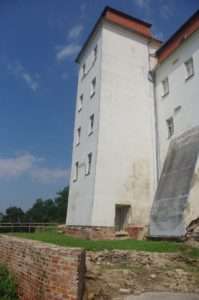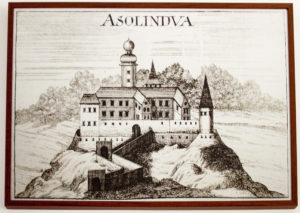Lendva

Lendva (Lendava) Castle is located in Slovenia but it used to be part of the Kingdom of Hungary. Lendva should not be confused with Felsőlendva (Gornja Lendava, German: Oberlindau) which is also in Slovenia. Now, I am describing Lendva (Lendava) which was called Dolnja Lendava/Alsólendva in 1935.

Since Gornja Lendava/Upper Lendava took the name GRAD (castle) in 1950, the name Alsólendva was changed to Lendava. As the settlement is bilingual, the official name is now Lendava-Lendva. Slovenia is very respectful of the Hungarian and Italian indigenous inhabitants of the country.


From the second half of the 12th century, 19 fortifications, including Lendva Castle, can be found on the lands of the German knights of the Hahót-Buzád clan in Zala County. However, small archaeological excavations carried out on the site so far have shown that the fortifications existed even earlier. The earliest known written document about medieval (Alsó) Lendva is a charter from 1192, which testifies to the ownership of the (Alsó) Lendva settlement by the Hahót (Hahold) family.

In the first half of the 13th century, the castle and settlement became the center of the Alsó Lendva branch of the Hahót-Buzád family. In the 13th century, after the Mongol invasion and the sieges of the Bohemian king Ottokar II, István I of Alsólendvai (István I of Hahót) had the building completely renovated. There are written sources from 1272 that Hahót of the clan Hahót called himself Lord of Lendva, (“dominus de Lindau”).

The Hahót clan later became the Bánffy family of Alsólendva. They were one of the most prestigious aristocratic families in Hungary for almost three centuries. The members of the family repeatedly held the titles of Ban (Duke) of Slavonia and Croatia, Chief Comes of Zala County, Royal Master Cupbearer, Table Master, Master Doorkeeper, Master High Steward, Chief Stable Master, Chamberlain and/or Country Judge. The highest dignity of the family was achieved by Bánffy János VI, who was appointed Palatine by King Szapolyai János of Hungary.

The development of medieval Lendva was greatly influenced by the Bánffy family. In 1366, King Louis I of Hungary granted Alsólendva the right to hold a fair on the day of Saints Simon and Judas, i.e. 28 October, with the same rights and character as, for example, the city of Buda. From 1378 Alsólendva was regularly listed as an oppidium, i.e. a market town. The town was also mentioned as a civitas in the land grant of 1389.

In the 15th century, Bánffy Miklós VI, an ardent supporter of King Matthias, was made a hereditary count in 1477. In 1474, the king sent him to Naples to meet his future wife, Beatrix. On 24 November 1474, the Neapolitan princess and her entourage, including the king’s mother, Szilágyi Erzsébet, arrived at Alsólendava Castle. Later, on 28 August 1480, King Matthias himself visited the castle.

The Bánffys converted to Protestantism at the time of the Reformation. In 1573 they established a printing press in the town, which became an important institution of Hungarian Protestantism. Rudolf Hoffhalter’s workshop produced several important publications, including three well-known books in Hungarian by the preacher Kultsár György.

After the Battle of Mohács (1526) and the conquest of Szigetvár and (Nagy) Kanizsa, Alsólendva was also threatened by the Turks. In the late 16th and early 17th centuries, the Turks regularly attacked the town and the castle. The most serious attack was the Turkish siege of 1603. The castle was defended by 800 soldiers with 12 cannons. Outside the castle, 500 horsemen and infantrymen awaited the attackers. An outer fortress housed 80 armed men. The defence was successful and the castle of Alsólendava never fell into Turkish hands.

In 1645 the Bánffy family died out on the male side, and the Nádasdy family inherited the Lendvai estate through the female line. When Nádasdy Ferenc was executed in 1671 for his involvement in the Wesselényi conspiracy, the castle and the estate of Lendva passed to the Crown.

A few years later the castle was given to Pál Esterházy, the Palatine of Hungary. The Esterházys had it rebuilt in the early 18th century in the Baroque style and, according to the 19th-century local historian Dervarics Kálmán, in the shape of an “L” as a sign of gratitude to Emperor (Leopold) Lipót I.

The castle also housed a school from 1872 to 1896. Between the two wars, the building was used as a barracks by the Yugoslav army, and after the Second World War, it was again used as a primary school. The outer walls of the fortress were demolished in 1947. Since 1972, the fortress has housed the bilingual Lendvai Gallery and Museum.

If you would like to read about the history of Felsőlendva (also in Slovenia), here is my article on it:
https://www.hungarianottomanwars.com/kingdom-of-hungary/felsolendva/

Dear Readers, I can only make this content available through small donations or by selling my books or T-shirts:
Please, feel free to support me with a coffee here:
You can check out my books on Amazon or Draft2Digital, they are available in hardcover, paperback, or ebook:
https://www.amazon.com/dp/198020490X or at https://books2read.com/b/boYd81

My work can also be followed and supported on Patreon: Become a Patron!http://Become a Patron!

[wpedon id=”9140″]

https://hungarianottomanwars.myspreadshop.com/all


https://hungarianottomanwars.myspreadshop.com/all































